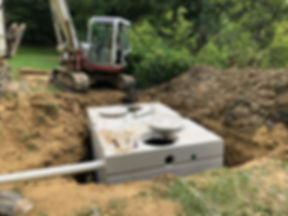
How It Works?
What happens when I flush my toilet?
This is a very common question. If you live in a town or city its simple, all the contents flush from your house and drain into the sewer system which eventually makes its way to a sewage treatment plant. If you own a home in the country however,your home is not connected to city sewer and so a septic system is required. In a nutshell, a septic system works in the following way. Anytime you use your toilet, sinks or washing machines, the liquid flows into a septic tank (usually between 500-1500 gallons) and then from there enters a leach field system which filtrates the water back into the ground.

A septic tank is a plastic,concrete, or metal tank located underground where all the plumbing in your house drains to. Septic tanks are only located on properties that don't have access to town or city main sewer pipes. You need to have your septic tank pumped regularly in order to keep the solid contents from reaching your leach field. Waiting too long could cause sewage to infiltrate your leach field eventually causing failure. Contact Us and we will be happy to pump your septic tank.
What is a septic tank?

What is a leach field?
A Leach Field is basically a mini sewage treatment plant. Water, sewage, grease, and soap flow out of your septic tank into a distribution box which directs the liquid into perforated pvc pipes which filter through sand and stone, and eventually go back into a natural water source. Depending on what type of soil you have, you may need a standard stone bed system or a sand filtration system. The size depends on how many bedrooms you have. At times, depending on the layout of your yard you may need a septic pump as well.

Is my septic tank full?
other common questions
one common misconception is when people ask if their septic tank is full. Technically, a septic tank is always "full" as you can see in the diagram on this page. The liquid level rises until it reaches the outlet pipe in your septic tank, where it then flows into the leach field.
How do I know if I need to pump my tank?
Determining when to pump your septic tank depends on a few factors. Normally we recommend for 1000 gallon tanks to be pumped every 3 years and a 1500 gallon tank to be pumped every 5 years. However, if you have many people in your home you may need to pump your tank more often.
What if I never pump out my septic?
We get this question a lot. Some people will say "Ive never had my septic pumped in 20 years and its still working fine!" Although your toilets may still flush, we don't recommend this. Over time, the "sludge" layer in your septic tank will keep building until eventually there is very little liquid left in the tank. When this happens, the "sludge" layer begins to travel into your leach field which will eventually cause total failure. Its much more cost effective to regularly maintain your septic than to risk having to need costly repairs.
Should I use Rid-X or other septic additives?
Many people wonder if they should use septic additives. We don't recommend them simply because if you properly maintain your system there is no need. Septic additives like Rid-X encourage bacterial growth inside your septic tank which breaks down sludge. However, there are already millions of tiny bacteria in your septic that already accomplish this. Regularly pumping your system and avoiding flushing harmful chemicals and grease will ensure your system will continue to work properly. Additionally, when you break it down, it is actually cheaper to pump your septic every few years than to add septic additives monthly.